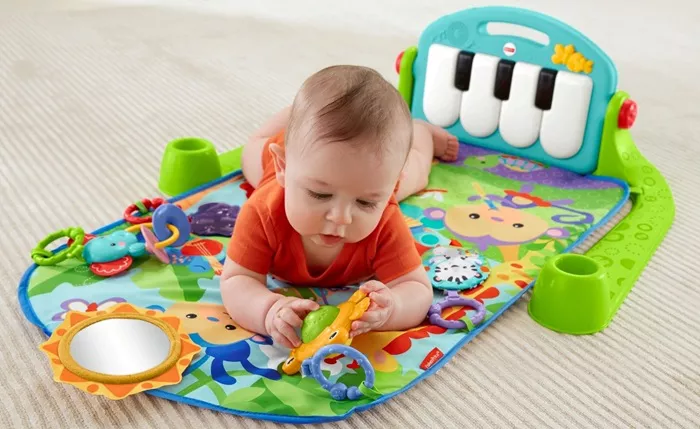A play mat is a soft, padded surface designed for babies and young children to play on safely. It provides a clean, comfortable, and secure space where babies can lie down, crawl, roll, and explore. Play mats often come with bright colors, patterns, and sometimes attached toys to engage a baby’s senses and encourage development. They are used both at home and on the go, offering a portable area for play and learning.
Why Are Play Mats Important for Babies?
Babies spend a lot of time on the floor during their first year. The floor, however, can be hard, cold, or dirty. A play mat protects babies from these issues by providing a soft, clean, and safe area. This helps parents feel confident letting their babies explore and move freely. Play mats also support important activities like tummy time, which helps build muscle strength needed for milestones such as sitting, crawling, and walking.
Benefits of Using a Play Mat
Supports Motor Skill Development: Play mats encourage babies to move their arms and legs, helping strengthen muscles for crawling and walking.
Encourages Hand-Eye Coordination: Many play mats have colorful designs and hanging toys that motivate babies to reach, grab, and explore, improving coordination.
Stimulates Cognitive Growth: Bright colors, patterns, and textures on play mats engage babies’ senses, helping their brain develop through play.
Provides a Safe and Hygienic Space: Play mats create a barrier between babies and dirty floors, reducing exposure to germs and allergens.
Portable and Convenient: Many play mats are lightweight and foldable, making them easy to carry for visits or outdoor play.
Comfortable Surface: The cushioning protects babies from hard floors and cushions small falls as they learn to move.
How Play Mats Help Baby Development
Gross Motor Skills
Gross motor skills involve large muscle groups used for movements like rolling, crawling, and walking. A play mat offers a soft surface where babies can practice tummy time, which strengthens their neck, shoulders, and arms. This muscle strength is essential for sitting up and crawling safely.
Fine Motor Skills and Hand-Eye Coordination
Play mats often include toys or patterns that encourage babies to reach out and grasp. This helps develop fine motor skills and hand-eye coordination, which are important for later tasks like feeding themselves and writing.
Cognitive and Sensory Development
The colors, shapes, and textures on play mats stimulate babies’ senses. Interacting with these elements helps babies learn about cause and effect, recognize patterns, and develop early problem-solving skills.
Materials and Types of Play Mats
Play mats come in different materials, each with benefits:
Foam Mats: Thick and cushioned, foam mats provide excellent padding and shock absorption. They are ideal for protecting babies during falls but can be heavier and less portable.
Fabric Mats: Usually thinner and softer, fabric mats are lightweight and easy to fold for travel. They often include attached toys or arches for interactive play.
Water or Gel-Filled Mats: Some play mats have a clear section filled with water or gel and floating toys inside. These stimulate visual tracking and sensory exploration.
Safety Considerations When Choosing a Play Mat
Safety is key when selecting a play mat for your baby. Here are important points to consider:
Non-Toxic Materials: Choose mats made from BPA-free, hypoallergenic, and non-toxic materials to avoid harmful chemicals.
Tested Safety Standards: Look for mats tested to standards like EN-71, which ensure they are safe for babies to mouth and chew.
Shock Absorption: The mat should be thick enough to cushion falls but firm enough to support movement.
No Small Parts: Avoid mats with detachable small pieces that could be choking hazards.
Easy to Clean: Babies can be messy, so mats should be wipeable or machine washable to maintain hygiene.
How to Use a Play Mat Effectively
To get the most from a play mat, place it in a safe area free from sharp objects or hazards. Use it daily to encourage tummy time and play. Engage with your baby by placing toys on the mat or lying down next to them. This not only supports development but also strengthens your bond. Remember to clean the mat regularly and inspect it for wear or damage.
When to Introduce a Play Mat
Babies can start using a play mat as early as a few weeks old. Around 1 to 3 months, tummy time on a play mat helps build neck and upper body strength. As babies grow and begin to roll, sit, and crawl, the mat provides a safe space to practice these skills. Many children continue to enjoy play mats well into toddlerhood as a comfortable play area.
Choosing the Right Play Mat for Your Baby
Consider your baby’s age, developmental stage, and your lifestyle when picking a play mat. If you travel often, a lightweight, foldable fabric mat might be best. For home use, a thick foam mat offers more cushioning. Look for engaging designs that encourage sensory and motor development. Always prioritize safety and easy cleaning.
Additional Uses of Play Mats
Besides play and tummy time, play mats can be used for:
- Safe floor seating for toddlers learning to sit.
- A soft surface for diaper changes or naps.
- A clean area for older children to do puzzles or crafts.
- A portable play area when visiting family or friends.
Conclusion
A play mat is an essential tool for supporting a baby’s early development. It provides a safe, clean, and comfortable space that encourages movement, exploration, and learning. By promoting motor skills, hand-eye coordination, and cognitive growth, play mats help babies reach important milestones. Choosing a safe, age-appropriate mat and using it regularly can make a big difference in your child’s growth and happiness.
Related topics:


